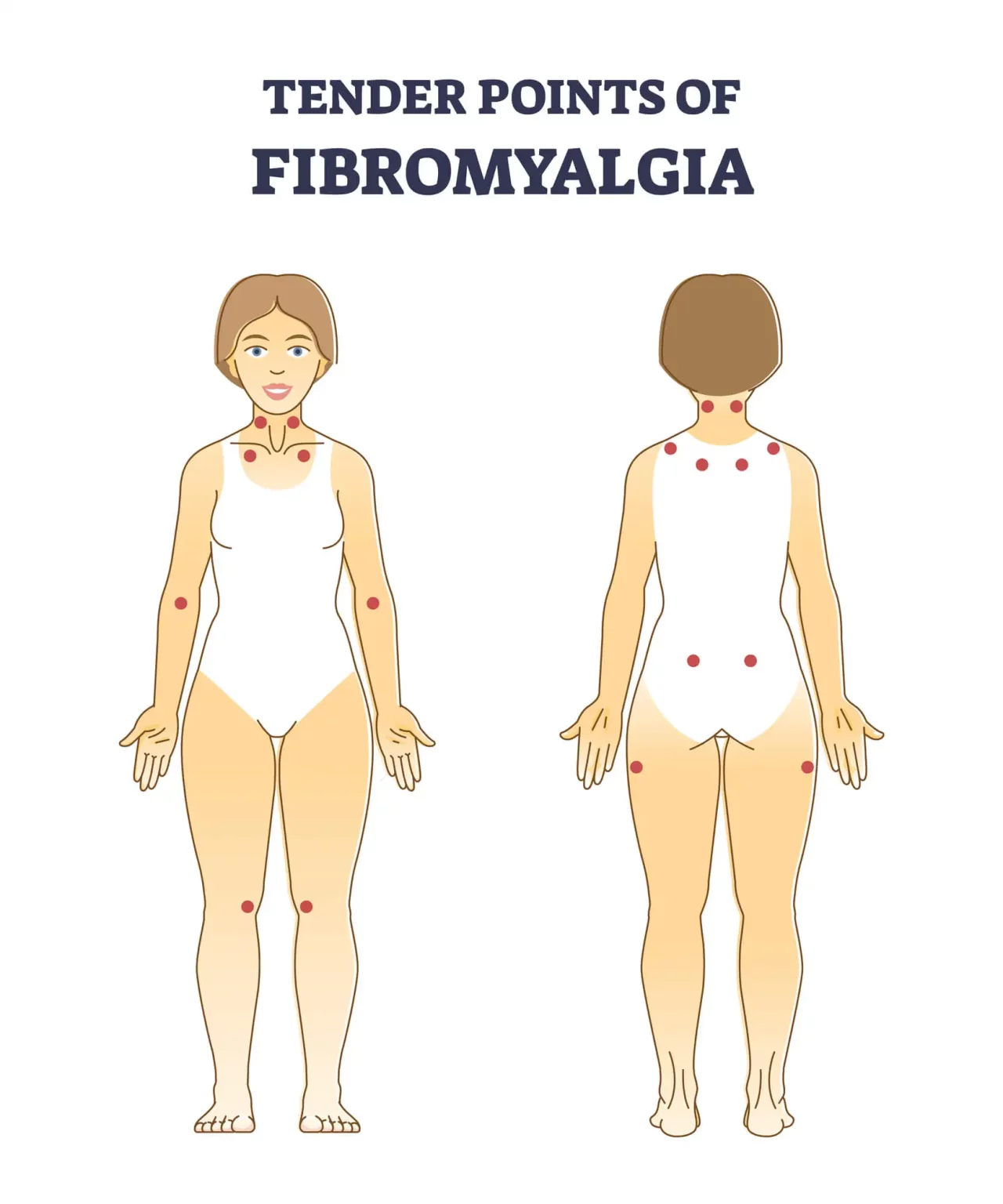Fibromyalgia can be an incredibly debilitating condition that causes severe pain and fatigue that can prevent you from engaging in everyday activities. In fact, people with fibromyalgia tend to be more sensitive to pain in general. Yet, as debilitating as the condition sounds, a surprising number of people suffer from it. It’s estimated that over 40 million adults in the U.S. alone have fibromyalgia, accounting for roughly 2 percent of the adult population in the U.S. Although there isn’t a cure for fibromyalgia, there are effective ways that you can treat the condition to manage the pain and fatigue so that it does not affect your quality of life.
What Is Fibromyalgia?
Fibromyalgia is a chronic disorder. It’s characterized by widespread musculoskeletal pain, sleep disturbances, fatigue, and other symptoms. This condition can affect any part of the body but is commonly found in the neck, shoulders, lower back, hips, arms, and legs.
The condition affects the central nervous system, causing the body difficulty processing pain signals accurately. In severe cases of the condition, the pain receptors in the brain become more sensitive, causing them to overreact to the slightest sensations.
Fibromyalgia Trigger Points
Trigger points are areas of tight muscle that cause pain when pressed. They can be found in many areas of the body, including the neck, shoulders, upper back, lower back, arms, and legs. A person with fibromyalgia may experience pain in these areas even without pressure being applied. The pain associated with these points is often described as a sharp or burning sensation.
Fibromyalgia Trigger Points Diagram

Pain may start in one area and then spread to nearby regions, affecting them as well. If you look at the diagram of fibromyalgia trigger points, you’ll see how pain can radiate outward from certain areas. The diagram also illustrates how fibromyalgia pain can be felt in multiple regions of the body. This is known as “bilateral” or “polysymptomatic” pain, which means the pain is felt on both sides of the body.
Symptoms of Fibromyalgia
Symptoms of fibromyalgia can vary from person to person but generally include the following:
Pain and Swelling
Pain is the most common symptom of fibromyalgia and can range from a mild ache to intense throbbing. This pain usually occurs in multiple areas of the body, including the neck, shoulders, lower back, hips, arms, and legs. Swelling may also occur in these areas but typically subsides after a few days.
Stiffness and Reduced Range of Motion
Stiffness and reduced range of motion are also common symptoms of fibromyalgia. This can make it difficult to move, stretch, or bend the affected areas of the body. Joints may also feel swollen and tender. The cause of these symptoms is believed to be related to the abnormal levels of hormones and chemicals in the body that are associated with fibromyalgia.
Grating Sensation
Another symptom of fibromyalgia is a grating sensation in the muscles, often described as “crepitus.” This is caused by the accumulation of tiny calcium deposits in the muscles, which can cause them to become stiff and sore. These calcium deposits accumulate due to an imbalance of hormones and chemicals in the body, which is commonly found in people with fibromyalgia.
Crepitus
Crepitus, which is the term used for the grating sensation that affects your joints, often indicates a more significant underlying problem. It is the crunching, cracking, or popping sound and sensation felt when your joints move. It can be caused by...
Stiffness and Limited Range of Motion
Although it’s normal for people to experience some level of stiffness or reduced range of motion as they age, it may be a sign of an underlying health condition if the issue persists or is causing significant discomfort. When the range of motion of a joint...
Muscle Spasm In The Stomach
Experiencing a muscle cramp can be painful and uncomfortable. While cramps can occur in any area of the body, muscle spasms in the stomach are particularly common. In fact, almost everybody will experience muscle spasms of some kind throughout their lifetime....
Pain In The Lower Back And Legs
Lower back pain can extend beyond the back itself and affect both the gluteal muscles and the many muscles of the legs. This typically occurs as a result of nerve irritation or compression in the lumbar region. When the nerves of the lower back become...
Joint Pain And Swelling
Joint pain is arguably one of the most common musculoskeletal complaints among adults of all ages. But the fact that this condition is so widespread does not mean that it isn't life-limiting, or that it should be overlooked. Joint pain and swelling can cause...
Cognitive Impairment
Cognitive impairment describes any decline in cognitive abilities, such as memory, language, problem-solving, and attention. Such impairments can be a sign of more serious conditions, such as dementia or Alzheimer's disease, but they can also be the result of...
Difficulty Focusing
Difficulty focusing or concentrating refers to the inability to maintain attention on a specific task for an extended period. It can manifest in various forms, such as being easily distracted, having trouble staying organized, and feeling overwhelmed by...
Muscle Spasm
Muscle spasms are sudden, involuntary contractions of one or more muscles. These contractions can be painful and cause your muscles to tighten up or go into a knot. Muscle spasms can affect any muscle in the body and may last from a few seconds to several...
Muscle Spasm In Back Of Thigh
Besides causing ongoing discomfort, chronic pain can significantly decrease your quality of life, increase the risk of other mental and physical disorders, and cause you to deal with astronomical healthcare costs....
Muscle Spasm In Neck
Muscle spasms that occur in the neck can range from mildly irritating to painful and disruptive to day-to-day life. Not only can they be uncomfortable, but they are often the result of underlying conditions that can cause other symptoms as well. Along with...
Muscle Spasm In Rib Cage
Intercostal muscle strain is a type of soft tissue injury caused by overstretching or tearing the muscles between your ribs. It usually occurs as a result of repetitive movements such as lifting heavy objects, coughing, or sneezing. This can lead to pain and...
Muscle Spasm In The Arm
Experiencing muscle spasms in the arm can be quite uncomfortable and disruptive, as they may interrupt your daily life. However, with the right understanding and treatment approaches, they don’t have to stop you from doing the activities you enjoy. Whether...
Muscle Spasm Near Elbow
Muscle spasms aren't always a cause for concern, especially if they rarely occur. However, regular muscle spasms should be taken seriously and managed accordingly - especially if you're experiencing additional symptoms, such as pain. Frequent muscle spasms,...
Fatigue And Irritability
Irritability and fatigue can significantly impact your quality of life by hindering daily activities and provoking distress. While treatment may be complicated, with an accurate diagnosis and early intervention, you can reduce the impact of tension headaches...
Tender Lymph Nodes
Everyone has experienced swollen and tender lymph nodes at some point in their life. It’s a common symptom that can be caused by various factors. Although it’s usually not a cause for concern, understanding the underlying reasons behind swollen and tender...
Tendon Pain
When you are suffering tendon pain and inflammation, it not only causes discomfort but can directly impair normal mobility. The level of impact will vary based on the affected tendon but activities such as running, walking, lifting objects, or using fine...
Back Pain
Back pain is an awful problem that many individuals have encountered. It has the potential to restrict normal mobility and functionality, significantly impacting a person’s quality of...
Causes Of Fibromyalgia
Fibromyalgia is a complex condition, and the exact cause is unknown. However, multiple factors lead to the development of this condition. The following are believed to be some of the most common causes:
Abnormal Pain Messages
People with fibromyalgia are thought to experience abnormal pain messages between the brain and the body. Usually, the brain blocks out some of the pain signals it receives from the body, but in people with fibromyalgia, these messages are not blocked out and can lead to increased sensitivity to pain. As a result, even the slightest injury or sensation can become magnified and cause extreme discomfort.
Genetics
Genetics is believed to play a role in the development of fibromyalgia. Having family members with the condition increases your risk of developing it, although it is not the only factor. Additionally, it’s worth noting that women are twice as likely to develop fibromyalgia than men.
Events Causing Physical/Emotional Stress
Experiencing physical or emotional trauma can also increase your risk of developing fibromyalgia. This could be trauma caused by a car accident, surgery, or even an emotionally traumatic event. This is because the body releases hormones during times of stress, which can lead to an imbalance of hormones and chemicals. As such, people with PTSD are at risk of developing the condition as well.
Associated Conditions
Some medical conditions, such as rheumatoid arthritis and lupus, are associated with an increased risk of developing fibromyalgia. Additionally, having depression or anxiety may increase your risk as well.
Fibromyalgia Diagnostic Procedure
The diagnosis of fibromyalgia is a process that should involve both the patient and the healthcare professional. It begins with a physical exam to rule out any other causes for the symptoms the patient is experiencing. Next, the doctor may take blood tests to check for inflammation, anemia, or other conditions that could be causing similar symptoms. If the tests return normal, the patient may be referred to a rheumatologist or pain specialist for further evaluation.
A doctor must also consider the patient’s medical history and current symptoms to make an accurate diagnosis. This involves a patient being asked questions about their pain and tenderness, as well as a physical exam to look for certain tender points.
Differential Diagnosis Of Fibromyalgia
A differential diagnosis is essential in any medical condition, as it helps rule out other conditions that may be responsible for a patient’s symptoms. This involves taking into account the patient’s medical history, current symptoms, and physical exam results. For example, in the case of fibromyalgia, a doctor may use a variety of tests and examinations to look for conditions such as chronic fatigue syndrome, lupus, rheumatoid arthritis, or Lyme disease. The doctor may also look for psychological disorders such as depression or anxiety.
By ruling out other conditions, the doctor can confirm a fibromyalgia diagnosis and begin treatment. Differential diagnoses are important because if an incorrect diagnosis is made, it can lead to unnecessary treatments that may not be effective. Therefore, correctly diagnosing fibromyalgia is essential for successful treatment and improved quality of life.
Conventional Treatment Options For Fibromyalgia
Conventional medical professionals that diagnose their patients with fibromyalgia may generally recommend non-surgical treatment options to manage the symptoms. These can include the following:
Medication
Medications such as antidepressants, pain relievers, and muscle relaxants can help reduce the severity of existing symptoms. Additionally, sleeping pills may be prescribed to improve sleep quality in patients who have insomnia. However, it’s important to note that such medications only treat the symptoms, not the underlying cause of fibromyalgia. As such, they’ll only provide temporary relief — and some medications can have side effects.
Exercise and Physical Therapy
A regular exercise program that includes aerobic exercises, stretching, and strengthening activities can reduce pain and improve overall physical functioning by increasing flexibility and range of motion. Physical therapy sessions can also help reduce the severity of symptoms by providing targeted exercises and stretching. Finally, exercise and physical therapy can help reduce stress and improve sleep, both of which can contribute to overall symptom relief.
Prognosis and Life Expectancy
The prognosis for fibromyalgia is generally positive as long as the condition is correctly diagnosed and treated. However, without treatment, the quality of life of patients with fibromyalgia can diminish significantly depending on the severity of the symptoms. The most significant risk is the high rate of major depression that adults with fibromyalgia have (they are three times more likely to develop depression than adults without the condition).
Fortunately, most individuals can manage their symptoms with appropriate treatment and lifestyle changes and continue living normal lives. In terms of life expectancy, individuals with fibromyalgia have the same life expectancy as people who don’t have the condition. However, it is essential to remember that fibromyalgia is a chronic condition, and symptoms can flare up periodically. As such, lifestyle changes and preventative measures should be taken to manage symptoms and reduce the risk of flare-ups.
How Neurofunctional Pain Management Manages Fibromyalgia
We use Neurofunctional Pain Management (NFPM) to treat fibromyalgia. This approach combines hydration therapy, high pulse electrical stimulation, and lifestyle counseling to target the underlying cause of chronic pain. The NFPM protocol is a whole-person, non-opioid, non-chiropractic, and non-invasive approach to treating chronic pain, meaning that it’s one of the safest and most effective long-term pain management solutions available. The following is a brief breakdown of the different techniques that we use to treat fibromyalgia:
Electroanalgesia
Electroanalgesia is a pain management technique that uses high-pulse electrical current to ease pain, boost blood circulation, improve mobility, and induce...
IV Therapy
IV nutritional therapy, or intravenous therapy, involves administering vital nutrients directly to the bloodstream through an IV. This type of treatment bypasses the digestive system, allowing for maximum absorption and utilization of nutrients by the...
Lifestyle Counseling
Lifestyle counseling is an approach to managing chronic pain that involves identifying, assessing, and modifying lifestyle factors contributing to an individual's pain. For example, lifestyle factors such as nutrition, physical activity, stress, sleep quality...
Regain A Pain-Free Life With The NFPM Protocol
Neurofunctional Pain Management protocol is designed to reduce pain, improve mobility, and help individuals with fibromyalgia lead a more active life. Treatment includes specialized hydration therapy, electroanalgesia, and lifestyle counseling to target the underlying cause of chronic pain. By taking a whole-person, opioid-free, non-chiropractic, and non-invasive approach to treating fibromyalgia, we can help our patients regain a pain-free life without the need for potentially addictive medications or risky surgeries. With this evidence-based treatment protocol, we are confident that individuals with fibromyalgia are in the best hands with us.
If you or someone you know is struggling with fibromyalgia, we invite you to learn more about how we can help. Our team of medical experts is here to guide you through a comprehensive and personalized treatment plan tailored to your individual needs. Contact us today, and let’s get started on the road to a healthier and happier life.
It is time to effectively manage your pain from fibromyalgia. Explore Neurofunctional Pain Management today.










